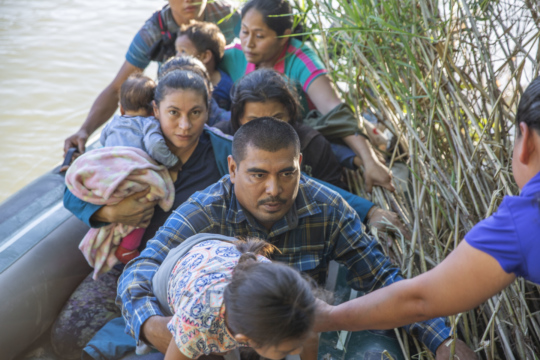
Canada’s Migration Policy Model
At the core of a country’s sovereignty and identity is determining who comes, who stays, and who is eligible for citizenship. Canada is a prime example of a successful migration policy in action.
This post is also available in: Spanish
In the last few months, the flow of migrants to the US-Mexican border has been labeled a “crisis” by the media, and Vice President Kamala Harris is now leading the Biden administration’s response. While preliminary data shows higher than average border crossings in the last few months, the majority of migrants are expelled in a matter of hours on account of Title 42 – the public health mandate enacted under former President Donald Trump that blocked most migrants from entering the United States to claim asylum. The focus on sheer numbers and the crisis-framing also obfuscate the human aspect of migration, the individual stories, and motivations of those who make the dangerous journey to the border, lumping them together under the generalized label “migrant.” One group that has been largely overlooked is domestic violence (DV) survivors and their claims to US asylum.
To be eligible for asylum under US and international law, a person must show a well-founded fear of persecution on the grounds of race, religion, nationality, political opinion, or membership in a particular group. In 2020, there were 151,800 total asylum applications from individuals in removal proceedings or at a US border or entry point, and today there are almost 1.3 million backlogged due to the large volume of applications and limited resources.
The approval rate of asylum applications has followed a steady downward trend over time, especially in the later years of the Trump administration. The countries most affected by high asylum application denial rates in 2020 are all in Latin America, including Honduras (87.3 percent), Guatemala (85.8 percent), Mexico (85 percent), and El Salvador (81.9 percent). These countries are also some of the most dangerous places in the world for women. In 2018, there were 13.49 femicides for every 100,000 women in El Salvador, the highest rate worldwide, and in 2021 so far, a femicide was committed in Honduras every 36 hours. This gendered violence is often a contributing factor for migration from Central America. Between 2014 and 2018, approximately 10,000 people per year were granted asylum due to gang violence or DV in their home countries. Although there is no exact data to show how many women are claiming asylum because of DV, there has been an increase in female migrant apprehensions from 2012 to 2017.
Asylum applications are filed with the Department of Justice’s immigration court system, known as the Executive Office for Immigration Review (EOIR). As part of the executive branch, the EOIR reacts directly to decrees or guidelines from executive officials. In 2018, the Trump administration used this influence to narrow the purview of asylum law and the ability of DV survivors to claim asylum. Led by former Attorney General Jeff Sessions, the administration argued that the grounds for asylum should not include domestic abuse because it is “private violence” rather than government persecution, upholding the misguided idea that violence against women is not a public health issue that warrants government protection. Human rights organizations challenged the use of these guidelines during the credible fear screening phase for asylum seekers in a federal court case. Although a federal judge ruled in their favor, this decision does not apply to the second phase when applicants are granted a court hearing. Judges can still use Sessions’ mandate to deny claims and some continue to do so.
In sharp contrast, President Joe Biden has publicly stated his commitment to prioritize gender equality and rights and explicitly acknowledged the link between domestic violence and migration. He campaigned on a pledge to reform the immigration system and reverse Trump’s policies. Three of Biden’s plans, all published ahead of the November 2020 election, reference asylum protections for domestic violence survivors. Biden’s Central America Plan outlines a massive effort to invest in the Northern Triangle to address the root causes of migration. Under the section related to the rule of law, it states that Biden will restore “full access” to asylum for DV cases. The “Biden Plan to End Violence Against Women” and “The Biden Plan for Securing our Values as a Nation of Immigrants” specify that the US Department of Justice will reinstate explicit asylum protections, rescinded by the Trump administration, for DV survivors whose home governments cannot offer protection. On International Women’s Day, his administration’s fact sheet included ensuring that women and girls who flee from domestic violence are afforded the opportunity to seek US asylum.
While several executive orders on immigration have been signed into law in the first months of Biden’s term, none fulfills the promise of reinstating asylum protections. Under Sec. 4 (b) (c) (i), EO 14010, the attorney general is ordered to conduct a comprehensive review of the rules, regulations, and internal guidelines governing asylum claims to ensure they comply with international standards. The attorney general was given a 180-day review period, which ends on August 1, 2021. While the steady undoing of the Migrant Protection Protocols (MPP) is a welcome step towards fixing some of the damage done by the Trump administration to the US asylum system, Biden officials have signaled that other reforms will remain on hold. Accordingly, Title 42 remains in place – against the recommendations of public health experts – and the majority of migrants are turned away at the border. Statements by White House Press Secretary Jen Psaki and Secretary of Homeland Security Alejandro Mayorkas tell asylum-seekers to wait.
In the days between now and the end of the mandated 180-day review, thousands of asylum seekers will remain in precarious positions and be potentially exposed to many of the same risks that originally led to their migration. Rather than waiting until August, the Biden administration should immediately restore eligibility for DV survivors and reverse the harmful mandate enacted by Attorney General Sessions. In the long-term, legislation is required to reform the immigration and asylum systems to make it difficult for an anti-immigration administration to dismantle protections. Comprehensive legislation should also include explicit protections for gender-based violence victims under the definition of a “particular group,” ensuring their asylum eligibility. Although the US Citizenship Act of 2021 aims to accomplish some of this, the bill is unlikely to move forward in Congress as is and may instead be broken down in a piecemeal approach.
The intersection of domestic violence and migration in the Northern Triangle necessitates the protection of survivors seeking asylum. Biden’s stated commitments to gender-based issues and promises made on immigration reform prior to the election call on the administration to immediately restore asylum protections for domestic violence survivors. If the universal human rights of women and girls are a priority for the United States, we need to take action at the border.
At the core of a country’s sovereignty and identity is determining who comes, who stays, and who is eligible for citizenship. Canada is a prime example of a successful migration policy in action.
This post is also available in: SpanishIn Latin America, violence against women and girls is pervasive and practiced with relative impunity. According to a November 2017 United Nations Development Program Report, Latin America has the highest rate in the world of gender-based sexual violence against women, and in Central America…
This post is also available in: Spanish “There is a broad underestimation [by US immigration court judges] of how dangerous the situation on the ground is in Central America. Most people… live in a constant culture of violence. For example, most of my teenage clients have witnessed someone being murdered on…

